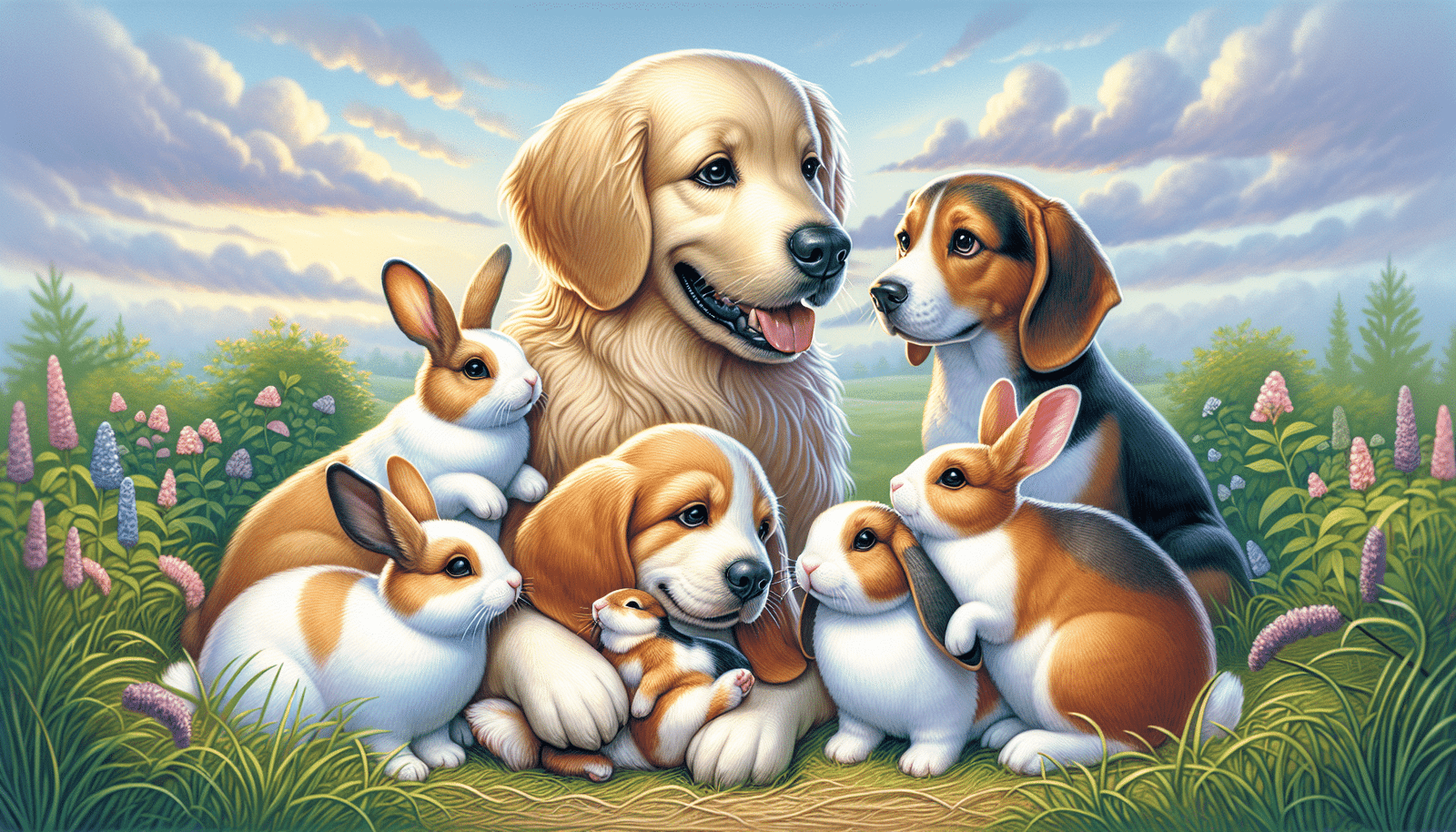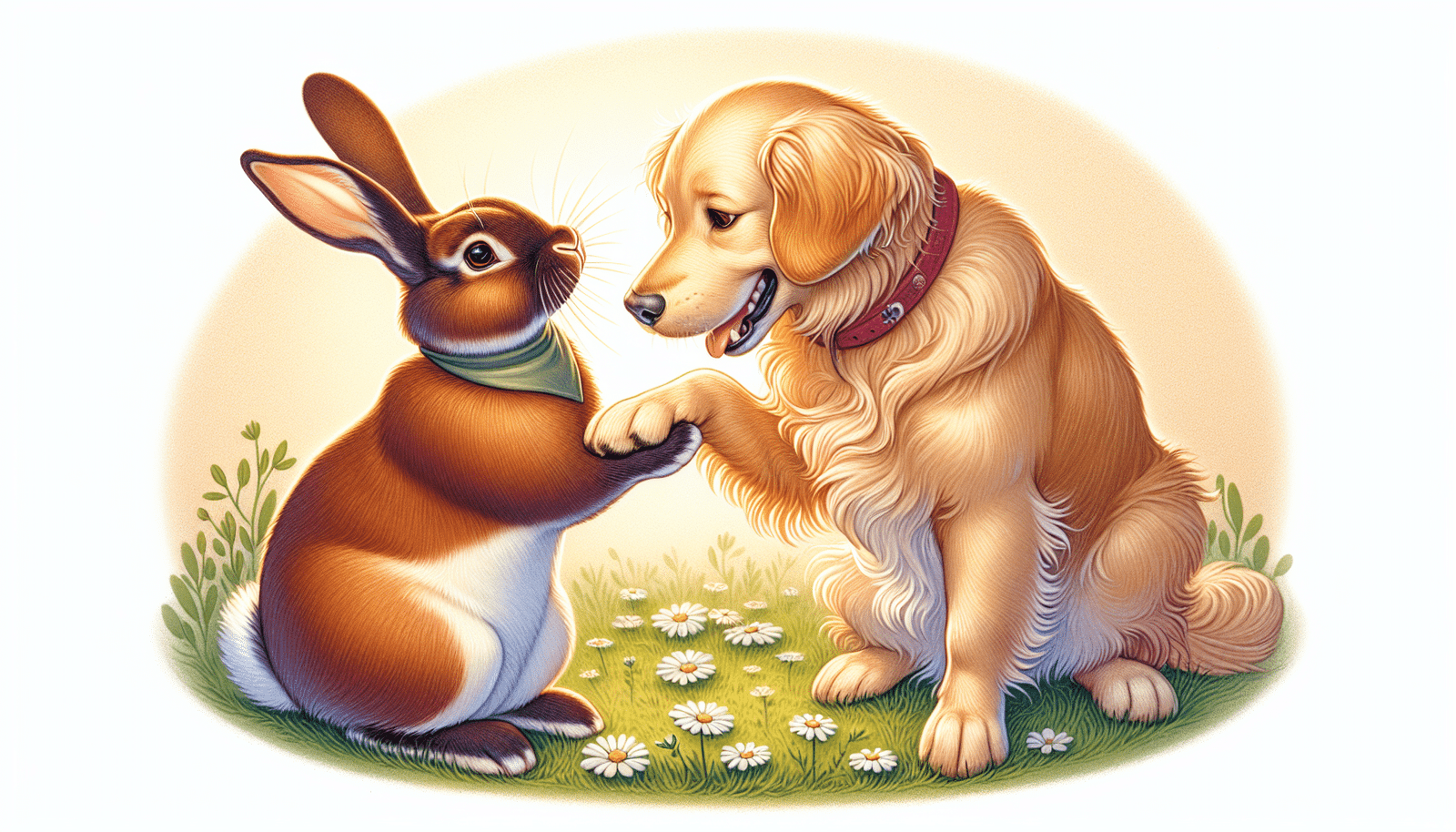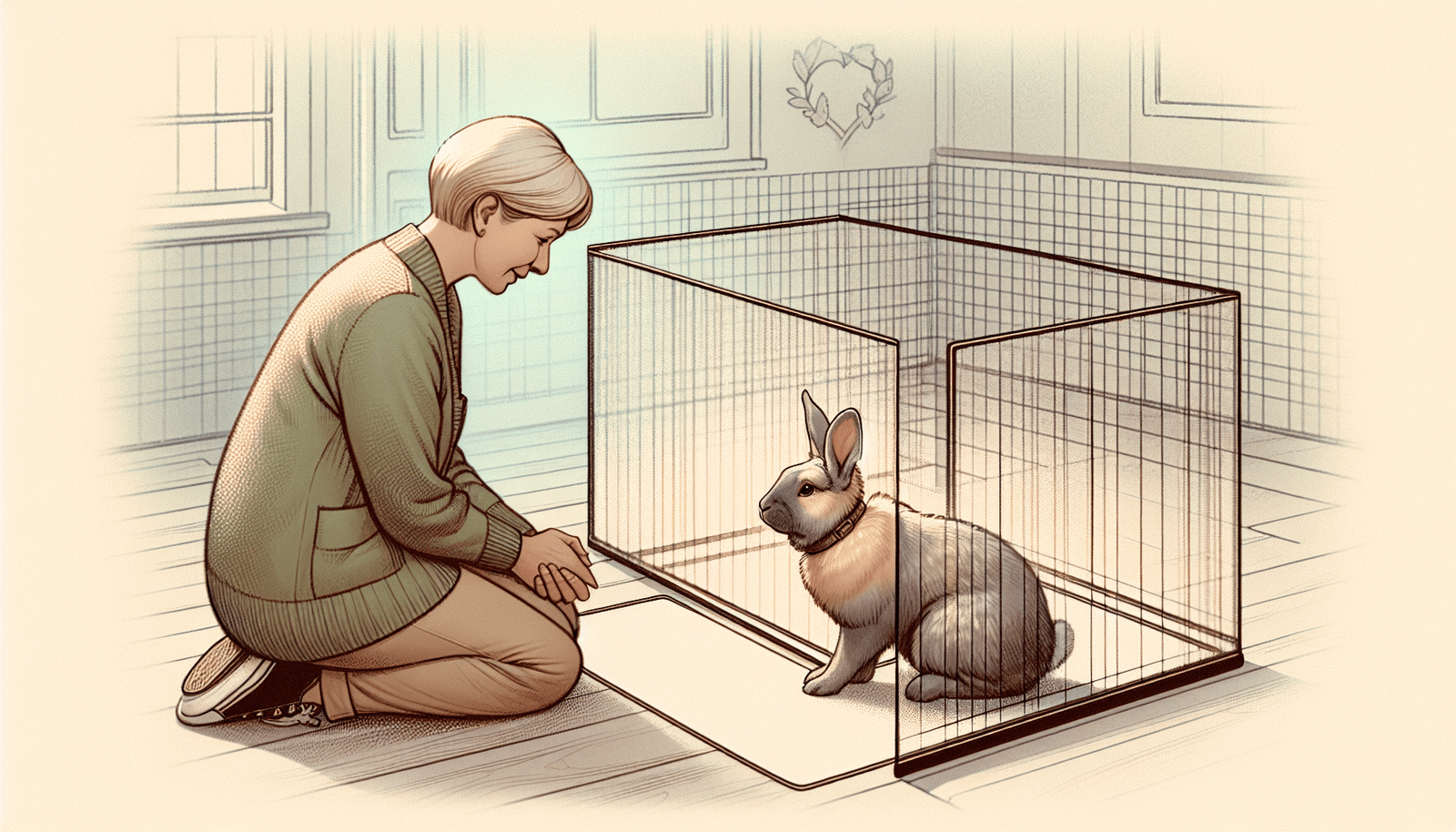Are you considering introducing a rabbit to your dog-loving household but concerned about how they’ll get along? The question isn’t just whether a dog with a rabbit, or “dog with rabbit,” can live together, but how to make their relationship work. This article dives into selecting compatible breeds, understanding prey drives, necessary socialization, and careful introductions, to help you create a harmonious haven for your furry friends.
Key Takeaways
- Dogs and rabbits can potentially coexist, but it highly depends on the dog’s prey drive, both animals’ socialization and individual personality traits, and the compatibility between the specific breeds of dog and rabbit.
- Careful and controlled introductions are crucial when trying to establish a relationship between a dog and rabbit, involving gradual, supervised interaction, training for impulse control, and understanding each pet’s body language to ensure safety.
- Maintaining a harmonious multi-pet household requires continuous management, including setting boundaries, ongoing training and supervision, health checks to prevent disease transmission, and adjusting to each pet’s needs to ensure their well-being over time.
Harmony or Havoc: Can Dogs and Rabbits Coexist?
Determining if dogs and rabbits can coexist peacefully is complex. It’s not simply a matter of putting the two animals together and hoping for the best. Several factors come into play, including the breeds involved, the inherent nature of the animals, and their temperaments. As one might expect, dog and rabbit breeds vary widely in their predispositions and behaviors.
A major factor to consider is the prey drive in dogs. Many dogs, regardless of breed, have an instinct to chase smaller animals. This can lead to risky situations where rabbits could get hurt or worse. Hence, when planning to introduce a rabbit to your household, it’s necessary to understand your dog’s prey drive.
Another key factor in the cohabitation of dogs and rabbits is socialization. Proper socialization can mitigate instincts and help the two species live together more harmoniously. Socialization plays a pivotal role in this process, requiring careful management for the mutual safety and welfare of both pets.
Lastly, individual personality traits play a significant role in determining the success of cohabitation between dogs and rabbits. Even within the same breed, dogs can display a wide range of personalities, which can greatly affect their interactions with rabbits.
Understanding Prey Drive-in Dogs
Prey drive in dogs refers to their instinctual urge to hunt and chase small animals. This is a natural behavior and can be more pronounced in certain dog breeds. For example, terrier breeds such as the Jack Russell, as well as lurchers and collies, have notably high prey drives.
A dog exhibiting behaviors like barking and lunging at small animals during walks suggests a strong prey drive, which could be problematic around rabbits. Hence, contemplating your dog’s breed and individual personality is significant when you plan to introduce a rabbit.
The Role of Socialization
In fostering a peaceful relationship between dogs and rabbits, socialization holds significant importance. Introducing these animals to each other in a neutral space can reduce territorial behavior and stress during their first meeting. Keeping these sessions short can prevent excessive excitement and possible stress or injury.
Over time, continuous and gradual introductions can build a routine and familiarity, easing the process of dog and rabbit cohabitation. It’s also vital to monitor the body language of both dogs and rabbits during introductions to ensure safety and gauge their comfort levels.
Individual Personality Traits
The personality traits of animals are key in determining the success of cohabitation between species. Dogs, regardless of breed, can display a wide range of personalities which can affect their interactions with rabbits. A thorough understanding of each animal’s personality contributes to creating a peaceful living environment for dogs and rabbits.
Considering the unique personality traits of each dog and rabbit is pivotal for their cohabitation in a shared space.
Selecting a Compatible Dog Breed

Choosing the right dog breed is a vital step towards fostering a thriving relationship between a dog and a rabbit. Certain breeds are renowned for their amiable, friendly, and reliable temperaments, naturally inclined to be gentle and non-threatening to smaller animals like rabbits. For instance, Golden Retrievers and Basset Hounds are recognized for these traits.
Numerous dog breeds are known for their affable personalities, and compatibility with other pets, and can make excellent companions for rabbits with the right training. These include:
- Maltese
- Japanese Chin
- Cavalier King Charles Spaniel
- Labrador Retriever
- Bichon Frise
Other breeds, such as the Coton De Tulear, Great Pyrenees, Golden Retriever, and Boxers, are also favorable choices due to their social cheerfulness and affectionate nature.
However, choosing a dog breed doesn’t just revolve around a mild-natured and friendly disposition. You also need to consider how the dog’s personality fits with that of your rabbit. A dog with a naturally calm demeanor and low prey drive may be an excellent match for a rabbit with a confident and outgoing personality.
Ultimately, nurturing a thriving relationship between a dog and a rabbit in the same household necessitates the careful selection of a dog breed with a nature mild and passive, as well as a friendly disposition. By understanding the traits and behaviors of different breeds, you can make an informed decision that prioritizes the safety and well-being of both your dog and rabbit.
Breeds with Lower Prey Drives
Certain dog breeds have intrinsically lower prey drives, making them potentially better companions for house rabbits. For instance, Basset Hounds are known for their laid-back nature and are less prone to chase, which can make them suitable companions for rabbits. Bernese Mountain Dogs are typically calm and gentle, making them less likely to view rabbits as prey and more as companions. The less intense prey drive in these breeds is often due to their historical roles or breed characteristics that do not involve active predation.
Historical Hunters: Proceed with Caution
While certain breeds have lower prey drives, some were bred for hunting, and these should be approached with caution. Breeds such as Huskies, Beagles, and Dachshunds have strong hunt-and-kill instincts towards small animals. Guard dogs like Belgian Malinoiss and German Shepherds have protective and chasing instincts that could lead to harmful interactions with rabbits.
Similarly, Greyhounds, Whippets, and Russian Wolfhounds, known as sighthounds, were bred for speed and agility, making them proficient hunters of small animals. These deeply ingrained prey drives present challenges in a cohabitant relationship with rabbits, as their instincts may trigger pursuit behaviors. Therefore, prioritizing breed compatibility is essential to establish a peaceful and safe environment for both dogs and rabbits, especially when considering huskies, greyhounds, beagles, German shepherds, and other breeds with strong prey drives.
The Unique Case of Big Dogs and Small Animals
Interestingly, large dog breeds, which one might assume to be more threatening to small animals, are often considered to be more docile and less predatory than other animals. This can make them better companions for small animals like rabbits. The success of a relationship between a large dog and a small animal depends on the dog’s personality, past experiences with small animals, and the animal’s temperament.
Therefore, don’t hastily rule out large breeds when searching for a canine companion for your rabbit.
Rabbit Compatibility: Choosing the Right Bunny Buddy

Just as crucial as selecting the right dog breed is choosing the right rabbit breed. Certain rabbit breeds, renowned for their confident and outgoing personalities, are more likely to harmonize with dogs. The breed of the rabbit plays a significant role in determining the likelihood of compatibility with canine companions.
Rabbits that display easy-going and relaxed attitudes are more inclined to foster a peaceful coexistence with a dog. Among the recognized rabbit breeds, some are distinguished for their great personalities and ease of care, making them better suited as house pets alongside dogs.
In essence, it’s about finding a rabbit breed that matches well with your dog’s personality and temperament. A rabbit possessing a confident and outgoing personality might harmonize well with a dog that displays a calm and patient demeanor.
The Sturdy and Sociable Breeds
Certain rabbit breeds that are known for their sturdy nature and sociability, making them well-suited to living with dogs, include:
- Flemish
- California
- Checkered
- Sussex
- Himalayan
- Dutch
These rabbit breeds are known to be sociable and are more likely to get along with larger pets such as dogs due to their non-intimidating nature. Choosing such a breed can increase the chances of a successful relationship between your dog and rabbit.
Delicate Breeds to Consider Carefully
Conversely, there are rabbit breeds that are more delicate and may require extra care and consideration when being introduced to dogs. Rabbits that show timid and fearful characteristics are less likely to have successful interactions with dogs. These rabbits may experience fear or stress when initially encountering dogs, necessitating careful and slow introduction processes. Some rabbit breeds that may require extra care when being introduced to dogs include:
- Netherland Dwarf
- Mini Lop
- Lionhead
- English Angora
It is important to be patient and monitor the interactions between rabbits and dogs to ensure the safety and well-being of both animals.
Hence, if you’re considering a more fragile rabbit breed, be prepared to dedicate extra time and patience during the introduction process.
Structured Introductions: Fostering Friendships Between Dogs and Rabbits

Once you’ve chosen the right dog and rabbit breeds, the next step is the introduction process. This is a critical phase that can set the tone for their future relationship. It’s crucial to manage initial interactions safely. Here’s how:
- Start by having the dog on a leash and the rabbit in a secure carrier.
- Gradually introduce the pets by starting with supervised, short sessions.
- Progressively increase interaction time as both animals show signs of comfort and acceptance.
However, the process isn’t solely about extending the interaction time. You also need to monitor for signs of distress in the rabbit, such as flinching or cowering. If you notice any such signs, it’s important to respond by calming the dog or ending the session if necessary.
Above all, safety should remain the paramount concern during the introduction process. You should continuously supervise interactions and be ready to separate the animals if needed.
Pre-Introduction Preparations
Before the actual introduction, it’s significant to train your dog in impulse control. This helps manage its urge to chase or harm unfamiliar creatures, such as a rabbit.
Training your dog before introducing it to a rabbit can significantly improve their initial interactions, making the introduction process smoother and safer.
Controlled Meeting Environments
The environment for introducing your dog and rabbit to each other also plays a key role. A neutral space is important to prevent territorial behavior and ensure neither animal feels its territory is being invaded.
Also, even friendly dogs need to be trained on how to interact with rabbits to prevent rabbits from experiencing stress due to dog behaviors perceived as playful.
Monitoring Interactions and Body Language
During the entire introduction process, closely observing the interactions and body language of both animals is vital. Dogs should be taught to treat rabbits as members of the family pack, and owners must proactively guide their dogs inappropriate behavior around rabbits.
After the initial introduction, continue observing your dog for several days to ensure they consistently demonstrates proper behavior around rabbits without barking, whining, or pawing.
Keeping the Peace: Maintaining a Safe Multi-Pet Household

Once the introduction phase is over, the focus shifts to maintaining a safe and peaceful multi-pet household. Several strategies can be implemented to ensure harmonious coexistence between your dogs and rabbits. For instance, feeding areas for dogs and rabbits should be kept separate to prevent any potential conflict over food.
It’s also important to ensure that dogs do not chase their rabbits even in play, as it may reinforce predatory behavior. If you notice any signs of such behavior, it’s crucial to intervene immediately.
The ultimate goal is to ensure a comfortable and safe environment for both pets. To achieve this, it may be necessary to keep them housed separately if they can’t get along. By taking such measures, you can ensure the safety and well-being of both your dog and rabbit.
Establishing Boundaries and Safe Zones
Establishing boundaries and creating rabbit-safe zones for both the dog and rabbit is an integral part of maintaining a safe multi-pet household. Providing separate safe zones can help make the animals more comfortable during the introduction process, ensuring that each pet has a retreat space where the other will not intrude.
It’s also crucial to provide each pet with its own set of resources, including food, toys, cages, and litter boxes, to reduce conflicts. This approach aligns with the guidelines provided by the Pet Products Association appa.
Continuous Training and Supervision
Continuous training and supervision are fundamental to ensure appropriate behavior between dogs and rabbits. Basic obedience training for dogs teaches them to resist chasing and to comply with commands like ‘sit’ and ‘stay’. Successful integration of a dog with a rabbit requires the owner to be perceived as a leader, ensuring that the dog behaves obediently.
Using positive reinforcement techniques is the most effective way to train both dogs and rabbits.
When to Keep Them Apart
While we strive for harmonious coexistence, there may be times when it’s best to keep dogs and rabbits apart. If a dog and rabbit shows signs of discomfort or anxiety during interactions, they should be separated to avoid negative outcomes. It’s also important to note that a dog and rabbit should never be left together unattended due to risks of aggressive behavior that could occur unexpectedly.
Certain rabbit breeds may also become depressed in confined spaces, making it challenging to cohabitate with a dog.
Integrating Into the Family: Long-Term Considerations
Integrating dogs and rabbits into a harmonious family environment is not a one-time effort but a long-term commitment. Key elements for a prosperous long-term relationship encompass:
- Selecting individuals with a mellow temperament
- Factoring in giant dog breeds known for their patience
- Choosing the right combination of individuals that can coexist peacefully.
Proper management of multiple pets necessitates a balanced distribution of attention and resources among them. Even after the introduction of a new pet, older ones should continuously receive ample affection and attention to help them maintain their perceived significance in the family.
Another important aspect of long-term cohabitation is health and wellness checks. Regular health evaluations are essential for rabbits, who often conceal their illnesses, to establish a baseline for what is normal and to quickly identify any health concerns. It’s also crucial to prevent the transmission of diseases and parasites between dogs and rabbits, particularly when introducing a new animal to the home.
Managing Multiple Pets
Managing multiple pets in a household with many animals, such as dogs and rabbits, can be a challenging task, especially considering that a million houses have dogs. One aspect to consider is protecting wires and cables with durable covers to prevent rabbits from chewing on them and risking electrocution. Pet among which 63.4% are dogs, making it essential to ensure their safety alongside other animals in the household.
It’s also important to establish clear boundaries and hierarchy within the pet family, recognizing that older pets often take priority over new additions. By taking these steps, you can ensure that each pet receives the attention and care they need.
Health and Wellness Checks
Routine health checks are vital for both dogs and rabbits to ensure their overall well-being and avert disease transmission. Diseases like kennel cough in dogs may cause serious illness in rabbits, and both animals can pass fleas, worms, and other parasites to one another. Regular health evaluations can help establish a baseline for what is normal and quickly identify any health concerns.
Caregivers should also be trained by a veterinarian to perform systematic health checks on rabbits effectively.
Adjusting to Life Changes
Life changes, such as the introduction of a new pet, can be stressful for older pets. Even after the introduction of a new pet, older ones should continuously receive ample affection and attention to help them maintain their perceived significance in the family. Making them feel valued and loved can help ease the transition and maintain a harmonious household.
Summary
In summary, creating a harmonious household with dogs and rabbits is a multifaceted process that requires careful consideration of breed characteristics, individual personalities, and proper training and socialization processes. It’s about understanding the needs and behaviors of both dogs and rabbits and creating an environment that caters to these needs. While the process may seem daunting, the rewards of witnessing a thriving relationship between your dog and rabbit are well worth the effort.
Frequently Asked Questions
Can all dog breeds get along with rabbits?
Not all dog breeds can get along with rabbits, as some breeds have a high prey drive. It’s important to research and select a breed with a low prey drive and a friendly temperament.
Are there specific rabbit breeds that are better suited for households with dogs?
Certain rabbit breeds like Flemish and Dutch rabbits are known for their confident and outgoing personalities, making them better suited for households with dogs.
Can I leave my dog and rabbit together unsupervised?
It’s not recommended to leave dogs and rabbits together unsupervised, as there is a risk of aggressive behavior, even with training.
What should I do if my dog and rabbit don’t get along?
If your dog and rabbit don’t get along, it’s important to separate them to avoid stress and potential harm. Consult a veterinarian or pet behaviorist for guidance on managing their relationship to ensure their well-being.
How can I prepare my dog before introducing it to a rabbit?
Make sure to prepare your dog with impulse control training to manage its urge to chase or harm the rabbit before the introduction. Start with training sessions to teach your dog self-control and help them understand the boundaries.



